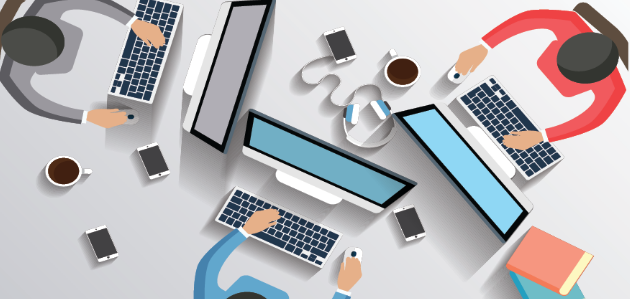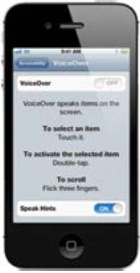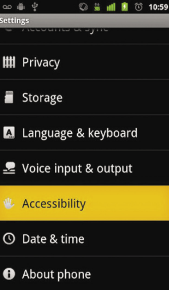This is the first in a series of articles in which we will describe state-of-the-art mobile technology relating to accessibility and usability for blind people. However, it is necessary to point out that talking about technology is, in many ways, not always simple. There is no lack of information about the subject. A wealth of information can indeed be found on the Web, though too redundant and not always organized in a logical manner. Another aspect that makes it difficult to write about correct and reliable information is the rapid change in technology. One thing can be true today, and not so true tomorrow, positively or not. We therefore invite readers to always double-check on the veracity of information found on the Web, as well as when any information is published. That being said, we will try to present a general overview of what the latest hardware and software technologies on the market have to offer at the time we write our articles. We will not go into depth about the individual operating platforms which will be addressed in future articles. Let us begin our discussion by stating some general tools which cannot be ignored when discussing the subject of accessibility and usability of mobile devices by visually impaired persons. The first tool to know about is the screen reader. The screen reader does exactly what its name says, it reads the content displayed on the computer screen, which is the main problem a blind person has when using computer technologies. What is displayed on the screen?

So, a screen reader is a software able to provide in a way other than visual the readable information displayed on the video monitor of the computer device. This type of software transmits information through technologies used by people who live with vision loss through other senses such as hearing and touch. A myth to dispel is that a smartphone or a tablet can be accessed as long as a voice synthesis is installed: wrong! The voice synthesis is a software that will speak a text in a synthetic voice. But how is the text sent to the voice synthesis? The screen reader takes the displayed content and sends it to the voice synthesis or TTS (Text-to-Speech) so that blind users can listen to it. This means that a computing device (computer, tablet, smartphone, etc.) has to have a screen reader installed in order to be more or less accessible and usable. The information gathered by the screen reader can be heard thanks to the voice synthesis, or touched thanks to a Braille device. Consequently, the screen reader and the speech synthesis are two different software. Regarding the Braille device: this device allows blind users to read in Braille (reading and writing code used by blind people) the information and content visible on the screen of a mobile or a stand-alone computing product, thus enabling visually impaired users to enjoy and acquire this information using the sense of touch. Because of its functional element, this device can be compared to the voice synthesis. The blind user has the choice to use a speech synthesis software or a braille display or even both. To summarize: accessibility and usability of a computing device for visually impaired individuals is possible through the use of the necessary screen reader software, and the voice synthesis or Braille reader. Let's take a general look at the most popular systems on the market anticipating some news on their usability and accessibility. At the time this article was written, we can say that there are essentially four platforms from which consumers can choose.

Apple platform: Includes devices such as iPhone, iPad and iPod with iOS operating system and a section on accessibility, where we can find among the options the screen reader for the blind called VoiceOver. In this case, we can talk about an Apple platform since the well-known company based in Cupertino produces both the hardware and software products.

Android platform: In this context, we must necessarily refer to a platform linked to the operating system, since there are different manufacturers and brands that use it in the hardware devices they develop. This operating system is developed by the major developer of the Web search engine, the worldwide-known colossal Google. It is, however, assisted by numerous companies contributing in terms of development and commercialization. This operating system also includes, among its features, a section relating to various accessibility options, that is a screen reader for the blind called TalkBack.
Windows Phone platform: Also in this case, we refer to the operating system developed by Microsoft, because the hardware devices on which the operating system is installed are primarily produced by the famous Finnish brand Nokia, which later Microsoft itself acquired. Manufacturers other than Nokia, albeit few of them, install Windows Phone on their devices. This platform has been marketed in more recent times. With the Windows Phone 10 version, the accessibility section of the operating system has been enhanced with a screen reader for the blind called generically voice assistant. The screen reader was already installed in previous versions of Windows Phone, but only for English-speaking users.
Blackberry platform: As for Apple, the Canadian brand has developed its own hardware and software system equipping it even with an accessibility section and a screen reader that, however, has always remained a beta version (test version). To date, there is no evidence to suggest that further development of both the proprietary system or the screen reader will take place. Blackberry, in fact, with its latest hardware device, has decided to embrace the Android operating platform, reasonably to ensure a boost for the brand itself from a decline that seems irreversible.
In the next few issues of the magazine, we will further discuss the various operational aspects of the systems we have mentioned. We will try to single out the advantages, disadvantages and individual characteristics from the point of view of the consumer and user. We will also try to trace a brief history on the evolution of accessibility relating to mobile devices, from their introduction on the market up to their current widespread commercialization.





.png)